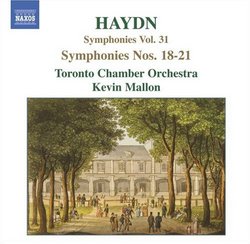| All Artists: Franz Joseph Haydn, Kevin Mallon, Toronto Chamber Orchestra Title: Haydn: Symphonies Nos. 18-21 Members Wishing: 0 Total Copies: 0 Label: Naxos Original Release Date: 1/1/2006 Re-Release Date: 7/25/2006 Genre: Classical Styles: Historical Periods, Classical (c.1770-1830), Symphonies Number of Discs: 1 SwapaCD Credits: 1 UPC: 747313265725 |
Search - Franz Joseph Haydn, Kevin Mallon, Toronto Chamber Orchestra :: Haydn: Symphonies Nos. 18-21
 | Franz Joseph Haydn, Kevin Mallon, Toronto Chamber Orchestra Haydn: Symphonies Nos. 18-21 Genre: Classical
|
Larger Image |
CD Details |
CD ReviewsMore Fine Performances of Early Haydn Symphonies J Scott Morrison | Middlebury VT, USA | 08/10/2006 (5 out of 5 stars) "This is the second and final instalment of recordings of early Haydn symphonies conducted by Kevin Mallon and played by the Toronto Chamber Orchestra (formerly, and on the earlier release, called the Toronto Camerata), all part of Naxos's recordings of all of Haydn's symphonies. The four symphonies recorded here are Nos. 18-21. Although numbered consecutively, these symphonies were not written in that order. Indeed, dating early Haydn symphonies is a bit dodgy, but suffice it to say that all of them were written in the early 1760s, when Haydn was in his twenties. And all but No. 21 were composed for Count Morzin before he went to work for Count Esterházy in Eisenstadt. The latter was possibly written as late as 1764. Haydn was in the midst, with these works, of creating the form of the symphony as we have come to know it. Nos. 18 and 19 are in three movements and have been called 'sonate da chiesa' ('church sonatas') because of their use of dotted rhythms and in No. 18 the use of a slow first movement. There is no reason to believe, though, that these symphonies were ever written for or played in a church. Nos. 20 and 21 have the usual four movements, but No. 21 has the somewhat unusual form of slow-fast-slow-fast movements.
With the exception possibly of No. 21, none of these four symphonies is one of Haydn's undisputed masterpieces, and although No. 21 has much to recommend it, it has usually been overshadowed by its successor, No. 22, probably because the latter has an easily-remembered subtitle, 'The Philosopher.' Frankly, I like No. 21 better, partly because of the innovative form of its first movement in which Haydn alternates two different ideas by using first all strings and then all winds. This movement is predominantly played sotto voce before bursting into a surprising forte and then followed by the two succeeding movements which crackle with energy. Kevin Mallon is an early-music conductor to pay attention to. He seems to have the ability to shape the music subtly, obtain crisp rhythms and brio from his orchestra, a fine 25-member group of Toronto musicians otherwise members of the Toronto Symphony, Canadian Opera and Ballet orchestras, and the Tafelmusik and Aradia ensembles. I like that the booklet names all the instrumentalists involved. Mallon uses a harpsichord continuo that is almost entirely unobtrusive; the use of continuo has always been a bit controversial in Haydn symphonies, but scholarship suggests that at the Morzin and Esterhazy establishments the harpsichord was used in the symphonies, at least the early ones. This release makes a fine companion to others in this series and can be recommended heartily. TT=60:59 Scott Morrison" |

 Track Listings (14) - Disc #1
Track Listings (14) - Disc #1